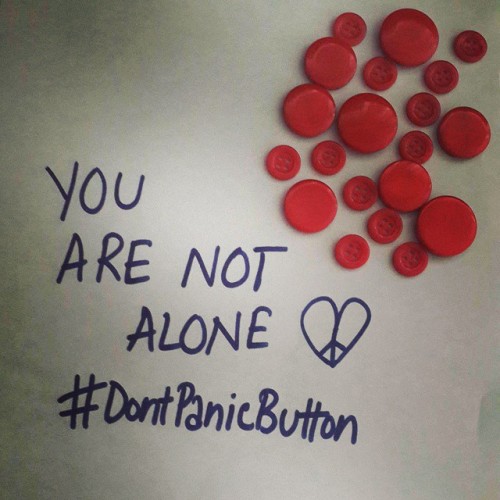Following up from my last post on mental health, I thought it would be a good idea to write a blog post about one of the less-spoken about issues - panic attacks! Due to the lack of information and advertisements on this subject, many people are oblivious about this aspect of mental health. However, panic attacks affect a large majority of people and fall under one of the most common types of disorders, closely linked with anxiety.
As an anxiety sufferer myself, this is a difficult subject to talk about and it frustrates me that even after hours of explaining, I'll never truly be able to make someone understand my emotions. Therefore, I feel it's my duty to write and inform others of the effects of anxiety, to help give you a better understanding and display ways in which you can show support. I dedicate this blog post specifically to my boyfriend as I've noticed in previous situations, he's had little idea how to diffuse the situation and sat helplessly, worrying on my behalf. Although recently I have seen an improvement, I still feel this would be a useful post - not only for him, but for many others having to deal with similar cases.

Anxiety is an awful feeling, which can be extremely difficult to control and is often triggered unexpectedly - whether that be through fear or stress. In brief, anxiety is a sudden feeling of dread, a rush of intense psychological and physical symptoms. The individual often feels alone, trapped and unable to escape - most often, fearing their life. Side effects include feeling nauseous, light-headed, headaches, blurry vision and/or general feelings of disorientation.
Everyone in their lifetime suffer with different levels of this, ranging from a small worry about facing school tomorrow to a major event such as using public transport. However, stress isn't always a bad thing - if you were always calm and collected, homework tasks and mundane chores would never get completed. Only extreme cases of anxiety can lead to panic attacks, which feel scary and life threatening to the individual.
As mentioned above, it's not always easy to understand how to deal with an anxiety sufferer in their time of need if you've never experienced a panic attack before. Therefore, I have listed some simple steps below to help diffuse a panicky situation:
As an anxiety sufferer myself, this is a difficult subject to talk about and it frustrates me that even after hours of explaining, I'll never truly be able to make someone understand my emotions. Therefore, I feel it's my duty to write and inform others of the effects of anxiety, to help give you a better understanding and display ways in which you can show support. I dedicate this blog post specifically to my boyfriend as I've noticed in previous situations, he's had little idea how to diffuse the situation and sat helplessly, worrying on my behalf. Although recently I have seen an improvement, I still feel this would be a useful post - not only for him, but for many others having to deal with similar cases.

Anxiety is an awful feeling, which can be extremely difficult to control and is often triggered unexpectedly - whether that be through fear or stress. In brief, anxiety is a sudden feeling of dread, a rush of intense psychological and physical symptoms. The individual often feels alone, trapped and unable to escape - most often, fearing their life. Side effects include feeling nauseous, light-headed, headaches, blurry vision and/or general feelings of disorientation.
Everyone in their lifetime suffer with different levels of this, ranging from a small worry about facing school tomorrow to a major event such as using public transport. However, stress isn't always a bad thing - if you were always calm and collected, homework tasks and mundane chores would never get completed. Only extreme cases of anxiety can lead to panic attacks, which feel scary and life threatening to the individual.
As mentioned above, it's not always easy to understand how to deal with an anxiety sufferer in their time of need if you've never experienced a panic attack before. Therefore, I have listed some simple steps below to help diffuse a panicky situation:
Step 1: if someone looks uncomfortable in a situation, offer some support - whether it be a smile or a gentle hug
Step 2: once involved, ensure that the sufferer is in a safe environment and protected from any potential harm
Step 3: try to understand how they're feeling and put yourself in their position
Step 4: remember that you are now in control of the situation, remain calm and maintain a soft tone of voice
Step 5: remind your friend/relative that they're not alone and that you're going to help them get through this
Step 6: ensure you have good eye contact at all times and encourage the sufferer to slow their breathing by focusing their concentration on your breathing pattern
Step 7: play some gentle music and remain close until they feel at ease again

Bye for now! Xxx
Step 2: once involved, ensure that the sufferer is in a safe environment and protected from any potential harm
Step 3: try to understand how they're feeling and put yourself in their position
Step 4: remember that you are now in control of the situation, remain calm and maintain a soft tone of voice
Step 5: remind your friend/relative that they're not alone and that you're going to help them get through this
Step 6: ensure you have good eye contact at all times and encourage the sufferer to slow their breathing by focusing their concentration on your breathing pattern
Step 7: play some gentle music and remain close until they feel at ease again

A really lovely post! You have listed some really amazing tips!
ReplyDeletegood luck!
fixmeinfortyfivex.blogspot.co.uk
x
Thanks, I love hearing your feedback on my posts! I hope this helps! xx
Delete